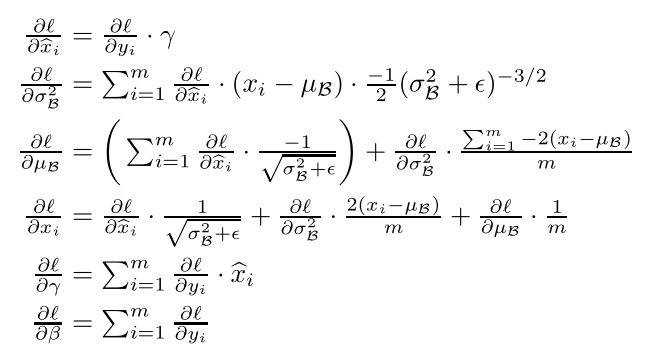Ok, so after checking also with the original authors - in the 3rd equation ($\partial \mathcal l/\partial \mu_\mathcal B$) the 2nd term does indeed simplify to 0.
The 4th equation ($\partial \mathcal l/\partial x_i$) however is not summed by itself but is multiplied as part of an outer product with the inputs to the layer - so when computing the gradient of the entire batch, we will have a vector of size $(N,)$ per neuron, or $(N,k)$ matrix per layer if we have $k$ neurons. To compute the downstream $\partial\mathcal l/\partial W $ we will do an outer product $a\cdot \partial\mathcal l/\partial x$ (where $a$ are the activations from the last layer / input to the current layer, and $\cdot$ is an outer product) [this is just one (simple) way to present it, we could also use tensors instead]. It's true that if we sum the matrix across the rows / batch it will sum to 0, but this is not what we do for the gradients.
Also note that in the 4th equation, $\partial \mathcal l/\partial \sigma^2_\mathcal B, \partial \mathcal l/\partial \mu_\mathcal B$ are of size $(,k)$ and need to be broadcast to the size of the matrix $(N,k)$ when computing the gradient for the entire batch.
Update: note that the 4th equation can also be simplified more if we plug in the $\partial \mathcal l/\partial \sigma^2_\mathcal B, \partial \mathcal l/\partial \mu_\mathcal B$ derivatives, and also replace some terms with $\hat x$:
$$ \frac{\partial \mathcal L}{\partial x} = \frac{1}{n \sqrt {\sigma^2+\epsilon}}[n\frac{\partial \mathcal L}{\partial \hat x} - 1^T\frac{\partial \mathcal L}{\partial \hat x}-\hat x(1^T\frac{\partial \mathcal L}{\partial \hat x}\hat x)]\\
$$
You can check the full derivation on this YouTube video I made here.

